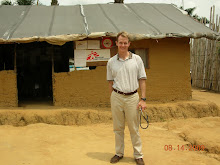
Walking down the street in Lubutu, local people dress in one of two ways.
Women, being wiser, wear lovely printed fabrics. These are purchased in the market as large pieces of cloth called pagne (pronounced “pahn-yah”, accent on the first syllable).

Out of the pagne is cut and sewn a top. The remainder encircles the waist, tucked into itself after one and half turns around the body. Generally the fabrics on the top and skirt are the same, but sometimes not. The clashes in color and pattern are fun.

In contrast, men’s clothing is boring, mostly used articles from the US. Every time I walk down the street I am amazed at the t-shirts—Suffolk County Athletic Department, Cincinnati Reds, souvenirs from Midwestern marathons, University of Texas. Men wear old Boy Scout shirts with all the patches still sewn on.
What about pants? How do the skinny Congolese men fit into the average American’s pants? They wear two or three pairs, one on top of the other. The whole package is tied with a piece of twine or rope. I complain about the heat wearing one pair of khakis. How do they tolerate it?

Today I stopped in the Lubutu market, looked around, and chatted with the vendors. I saw Gap shorts, Snoopy t-shirts, and Abercrombie and Fitch baseball caps. Some things were badly frayed but most were in decent condition. How did this stuff get here?
The vendors told me they buy in Kinshasa. Huge bundles of clothing containing mixtures of used pants, shirts, dresses, skirts, socks and underwear, are unloaded off boats. These bundles cost $150 US, a huge amount of money here. The buyer examines the exterior of the untied bundle and makes a purchase. From there the clothes take a 5 hour flight to Goma and change planes for Kisangani. From there it is four hours to Lubutu by truck. Placed in piles in the Lubutu market, they are sold to the local populace.
Unfortunately, a lot is still unknown. Were these clothes donated to charities? Are they things that resale shops could not sell in the US and are now being bought in Lubutu? How did these things get from Austin, San Francisco, or New York to Kinshasa? Who paid to ship them across the Atlantic? Why are the things for sale in Lubutu only from the US?
I still haven’t seen anyone wearing my old Boy Scout uniform, but I look for it every day.

No comments:
Post a Comment